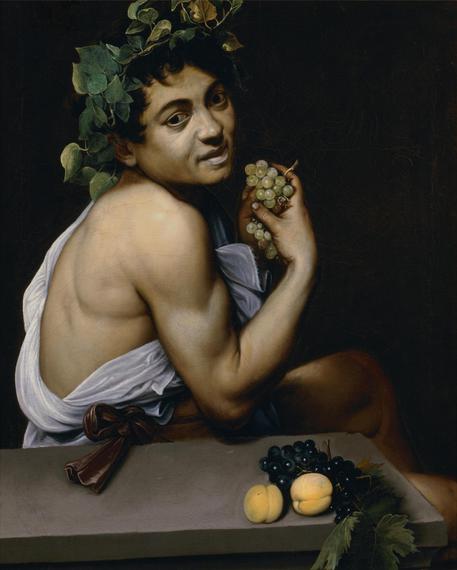
The exhibition ‘The Origin of the Still Life in Italy – Caravaggio and the Master of Hartford’ exploring the
evolution of Caravaggio’s still life painting opened at Rome’s Borghese Gallery and will be showing till
19th of February 2017. A total of 40 artworks are on display, together with works by the so-called Master
of Hartford, a mysterious young painter supposedly related to the Roman school (active c. 1600).
As part of the Roman artistic life of the sixteenth century, the Borghese Gallery has a superb exhibition
dedicated to the evolutions of Caravaggio’s painting. Around 1597, Caravaggio painted the famous
Canestra preserved at the Pinacoteca Ambrosiana in Milan, which marks a real break in his work and the
birth of a pictorial genre still little employed in Italy. For the first time, the “natural things” come their way
onto the canvas, as realistic representation of the unfettered nature of the human figure. Whoever was
behind the Master of Hartford, his personality is different from that of Caravaggio.
Protestantism, fear of idolatry and suspicion of figurative divine imagery gave powerful stimulus to the
development of still life painting in northern Europe, especially in the Low Countries. In Spain a grim
mysticism inspired artists such as Sánchez Cotán to combine the study of still life with the production of
more conventional Catholic images. In Italy, a single artist of genius, Michelangelo Merisi da Caravaggio,
established a third option, which was neither pro- nor anti-Reformation, but treated still life primarily as a
pure demonstration of artistic brilliance.
Caravaggio introduces a new idea: his fruits and leaves are not merely generic types with added details;
rather, they are described so specifically as to seem “portraits” of the plums and figs he bought that
morning in the market. Of course, that may only be part of the illusion.
Investigation would clear up a number of questions not immediately apparent as that the Basket of Fruit is
trompe l’oeil, a kind of archaeological homage to the illusionistic fruit baskets that were among the most
common motifs in the frescoes and mosaics in ancient Roman houses.
Of the many examples that survive, a recently excavated Basket of Figs in the Villa of Poppea in Oplontis
(Torre Annunziata, Naples) near Pompeii comes especially close to the painting. We have no examples of
the still lifes Caravaggio painted for Cavalier d’Arpino around 1593, two or three years before he painted
the Basket of Fruit. We know that ?Boy with a Basket of Fruit? (Borghese Gallery, Rome) is one of the
pictures that Caravaggio painted for Cavalier d’Arpino because it was still in d’Arpino’s possession when
his picture collection was confiscated through the papal fiscal agent in 1607 by Cardinal Scipione
Borghese, although the artist’s early biographers do not mention this painting.
Cavalier d’Arpino, was an art impresario, merchant, perhaps a collector as well as the most requested artist
in those days .
Defying conventional local wisdom, Caravaggio was quoted as saying that it took as much effort and skill
for him “to paint a good picture of flowers as one of figures.”
The exhibition includes such masterpieces as the ‘Basket of Fruit’, on loan from the Pinacoteca Ambrosiana
in Milan, as well as the ‘Young Sick Bacchus’ and the ‘Boy with a Basket of Fruit’ from the Borghese
Gallery collection .
The curators compared Caravaggio’s the ‘Young Sick Bacchus’ and the ‘Boy with a Basket of Fruit’ and the
four paintings discovered by Zeri from the Scipione Borghese collection in the 1970s and attributed to the
‘Hartford master’ in order to play up the contrast between the two styles: “drier and more wooden” for the
unknown painter, and full of the poetry of naturalism for Caravaggio.
Six of the paintings on display are all present in the Borghese collection since the early seventeenth century,
thanks to the desires of Cardinal Scipione: these are the two works of Caravaggio still in the collections
(Bacchus and the Boy with a Basket) and four still lifes that criticism tends to unite under the name of the
Master of Hartford.
The six paintings gather together again for the first time after 400 years on the occurrence of this excellent
exhibition. The organizers explained that an exhibition like this would inevitably take place inside the Villa
Borghese, because the story is intertwined with the history of this place. The exhibition begins by looking
at the tradition of naturalism in Caravaggio’s native Lombardy, represented by Vincenzo Campi, Giuseppe
Arcimboldo and Giovanni Antonio Figino. The latter is ascribed with painting the first-ever still life in
Italy: ‘Metal Plate with Peaches and Vine Leaves’ (1590-1594).
The Hartford master was the first painter to devote himself entirely to still life, while Caravaggio used the
genre to create his very personal painting revolution. The exhibition also explores the works of numerous
masters who followed in Caravaggio’s footsteps and devoted part of their output to still life. Caravaggesque
still lifes were being painted in Rome before 1607 and ergo even while Caravaggio was still in the city.
http://www.european-news-agency.de/kunst_kultur_und_musik/the_origin_of_the_still_life_in_italy_-66270/
(Carlo Marino)
